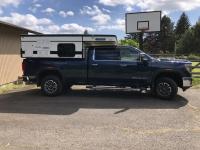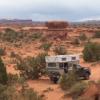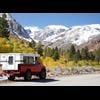Fantastic Fan opens itself and destroys itself: Easy to Remove and Replace with MaxxAir?
#21

Posted 04 November 2021 - 08:31 PM
Jon R
2021 Grandby Slide-in Front Dinette
2021 GMC 3500HD CC LB SRW Gas
1993 Chevrolet K2500 Ext Cab LB
#22

Posted 04 November 2021 - 08:57 PM
We have an extended cab; the front of the camper overhang is within 6 inches of the top of the windshield. Also, we have only experienced the problem with the front vent.
#23

Posted 04 November 2021 - 10:08 PM
In doing some additional research and talking with people who really understand aerodynamics, the consensus is that if the vent had been installed 6-12 inches or more further back, the air coming over the nose of the camper would not have affected the fan.
#24

Posted 04 November 2021 - 11:49 PM
In doing some additional research and talking with people who really understand aerodynamics, the consensus is that if the vent had been installed 6-12 inches or more further back, the air coming over the nose of the camper would not have affected the fan.
I could be wrong but yours is not a FWC and the front vent on your camper is very close to leading edge...I don't believe that any model of FWC has the vent that far toward the front of the top....also in mix is what else if anything you have on the roof...my two solar panels undoubtedly disrupt any laminar flow over the 2 FF vents...as speculated before , the type of camper mount, sitting in bed or on a bed frame and aero dynamics of your truck style could be factors...wish someone would post a series of photos showing the damage and suspected weak components...
#25

Posted 05 November 2021 - 12:06 AM
The front edge of my Grandby’s front vent lid is 27 inches back from the front of the roof.
Edited by Jon R, 05 November 2021 - 12:12 AM.
Jon R
2021 Grandby Slide-in Front Dinette
2021 GMC 3500HD CC LB SRW Gas
1993 Chevrolet K2500 Ext Cab LB
#26

Posted 05 November 2021 - 12:30 AM
I could be wrong but yours is not a FWC and the front vent on your camper is very close to leading edge...I don't believe that any model of FWC has the vent that far toward the front of the top....also in mix is what else if anything you have on the roof...my two solar panels undoubtedly disrupt any laminar flow over the 2 FF vents...as speculated before , the type of camper mount, sitting in bed or on a bed frame and aero dynamics of your truck style could be factors...wish someone would post a series of photos showing the damage and suspected weak components...
You are correct, it’s not a FWC but I believe some with FWC’s have had the same problem. And this problem seems to be limited to front vents. There’s enough disruption of air moving across solar panels, air conditioners etc. that the rear vents are rarely affected.
#27

Posted 05 November 2021 - 12:52 AM
As the air moves up from the windshield it will fall back downward onto the roof causing dirty air and a vacuum effect. So the air can actually be lifting the vent up ward. Air moving up the windshield has a positive pressure when it clears the roof line it is being sucked back down by negative pressure on the other side. I'm in a rush so I did not explained it very well....
Patrick
2015 FWC Hawk Flatbed
#28

Posted 05 November 2021 - 01:38 AM
As the air moves up from the windshield it will fall back downward onto the roof causing dirty air and a vacuum effect. So the air can actually be lifting the vent up ward. Air moving up the windshield has a positive pressure when it clears the roof line it is being sucked back down by negative pressure on the other side. I'm in a rush so I did not explained it very well....
I have a Yakima wind deflector just above my windshield, more to keep rain and debris out from under the Hawk over hang on my '05 Tundra AC and off the small tray of emergency gear I constructed on the Tundra roof using Yakima towers...anyway...the issue of aerodynamics notwithstanding...seeing actual photos of the damaged FF vents would be very helpful..
Pvstoy I think what you are describing is similar to the lift above an airplane wing where air moves faster over the curved surface creating less pressure there and hence lift...I could be wrong on this...
Edited by Wallowa, 05 November 2021 - 01:40 AM.
#29

Posted 05 November 2021 - 02:06 PM
As the air moves up from the windshield it will fall back downward onto the roof causing dirty air and a vacuum effect. So the air can actually be lifting the vent up ward. Air moving up the windshield has a positive pressure when it clears the roof line it is being sucked back down by negative pressure on the other side. I'm in a rush so I did not explained it very well....
I was thinking the same thing. It's similar to the uplift created by wind over a plane wing.
We replaced our FF with a Maxxair and have been very happy with the quiet 12 speed fan with instant reversing capability.
2021 RAM 3500 Crew 4x4, 6.4 hemi/8 speed trans with 4.10 gears, Timber Grove bags, Falken Wildpeak 35" tires.
OEV Aluma 6.75 flatbed, Bundutec Odyssey camper on order for 2024
For this year we're still using our 2008 FWC Hawk with victron DC-DC charger, 130w solar, MPPT controler
with 2000w inverter and external 120v output and 12v solar input with 100w portable solar. http://lighthawkphoto.com
#30

Posted 05 November 2021 - 02:14 PM
We have two very different campers (Granby, Bengal) with different vent brands/dimensions... and lifting of the front vent occurs on both. Opening and closing "polishes" the moving parts and so the friction "grip" eventually becomes too weak to hold the vent closed against the "air plane wing" vacuum. Everyone uses their vents differently and has a different starting friction and so "polishing" varies widely. We swapped handles between two vents and increased friction.
Our "cure": we fold stiff paper into a wedge or "T" shape("T" is better) and slip it between the handle and vent frame, snug but not too tight, wide end at the top. Removing and reinstalling the vent handle position in the closed spot to create the correct handle:frame space was required.
I suppose a piece of foam cut to the right shape would be another option to try.
Edited by iowahiker, 05 November 2021 - 02:15 PM.
0 user(s) are reading this topic
0 members, 0 guests, 0 anonymous users



















